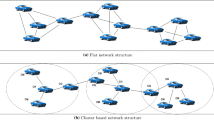Abstract
In order to overcome the high mobility problem of nodes in vehicular ad hoc networks (VANETs), the clustering algorithm can effectively improve the overall communication performance. This paper proposes an optimized timer-based passive clustering algorithm (OTPCA) for VANETs. Vehicles can choose to actively leave the cluster or not join the cluster based on the communication environment and performance. The vehicle can choose to communicate directly with the road side unit (RSU) and force it to remain for a timer. After the timer expires, it is re-evaluated whether it is suitable to join a cluster, and then repeat the operation. This can effectively solve the problem of node state stuck and improve the average communication performance. Simulation results show that the proposed algorithm is better then the passive multi-hop clustering algorithm in terms of average communication delay and control information transmission ratio.
Access this chapter
Tax calculation will be finalised at checkout
Purchases are for personal use only
Similar content being viewed by others
References
Baker, D.: The architectural organization of a mobile radio network via a distributed algorithm. IEEE Trans. Commun. 29(11), 1694–1701 (2003)
Taek, J.K., Mario, G.: Efficient flooding with Passive Clustering (PC) in ad hoc networks. SIGCOMM Comput. Commun. Rev. 32(1), 44–56 (2002)
Senouci, O., Harous, S., Aliouat, Z.: Survey on vehicular ad hoc networks clustering algorithms: overview, taxonomy, challenges, and open research issues. International J. Commun. Syst. (5) (2020)
Wang, S.S., Lin, Y.S.: Performance evaluation of passive clustering based techniques for inter-vehicle communications. In: Wireless & Optical Communications Conference. IEEE (2010)
Zhang, D., Ge, H.: Zhang T,: New multi-hop clustering algorithm for vehicular ad hoc networks. IEEE Trans. Intell. Transp. Syst. 20(4), 1517–1530 (2019)
Cooper, C., Franklin, D., Ros, M., Safaei, F., Abolhasan, M.: A comparative survey of vanet clustering techniques. IEEE Commun. Surv. Tutorials 19(1), 657–681 (2017)
Abuashour, A., Kadoch, M.: Passive CH election avoidance protocol and CH routing protocol In VANET. In: 2018 IEEE International Conference on Internet of Things (iThings) and IEEE Green Computing and Communications (GreenCom) and IEEE Cyber, Physical and Social Computing (CPSCom) and IEEE Smart Data (SmartData), pp. 1753–1758 (2018)
Ghadi, F., Touil, A.: Efficient dissemination based on passive approach and dynamic clustering for vanet. Procedia Comput. Sci. 127, 369–378 (2018)
Moore, G.L., Liu, P.: A hybrid (active-passive) clustering technique for VANETs. In: 2019 IEEE ComSoc International Communications Quality and Reliability Workshop (CQR). IEEE (2019)
Li, W., Tizghadam, A., Leon-Garcia, A.: Robust clustering for connected vehicles using local network criticality. In: Proceedings of the IEEE Internatiional Conference Communication (ICC), pp. 7157–7161, Ottawa, ON, Canada (2012)
Ghosh, R., Basagni, S.: Mitigating the impact of node mobility on ad hoc clustering. Wireless Commun. Mob. Comput. 8, 295–308 (2008)
Ucar, S., Coleri Ergen, S., Ozkasap, O.: VMaSC: vehicular multi-hop algorithm for stable clustering in Vehicular Ad Hoc Networks. In: 2013 IEEE Wireless Communications and Networking Conference (WCNC), Shanghai, pp. 2381–2386 (2013)
Qureshi, K. N., Bashir, F., Abdullah, A. H.: Distance and signal quality aware next hop selection routing protocol for vehicular ad hoc networks. Neural Comput. Appl. 6(4), 5916–5926 (2019)
Singh, R., Saluja, D., Kumar, S.: Reliability improvement in clustering based vehicular ad-hoc network. IEEE Commun. Lett. 24, 1351–1355 (2020)
Bononi, L., Felice, M.: A cross-layered MAC and clustering scheme for efficient broadcast in VANETs. In: 2007 IEEE Internatonal Conference on Mobile Adhoc and Sensor Systems, MASS, pp. 1–8 (2007)
Souza, E.D., Nikolaidis, I., Gburzynski, P.: A new aggregate local mobility (ALM) clustering algorithm for VANETs. In: 2010 IEEE International Conference on Communications, pp. 1–5. Cape Town (2010)
Goonewardene, R.T., Ali, F.H., Stipidis, E.: Robust mobility adaptive clustering scheme with support for geographic routing for vehicular ad hoc networks. Intell. Transp. Syst. IET 3(2), 148158 (2009)
The network simulator OMNeT++. https://omnetpp.org/. Accessed 10 June 2020
The Simulation of Urban Mobility (SUMO). https://sumo.dlr.de/docs/index.html. Accessed 10 June 2020
Acknowledgements
This work was supported by the National Key R&D Program of China under Grant No. 2016YFB1200100, and the National Nature Science Foundation of China under Grant No. 91638301.
Author information
Authors and Affiliations
Corresponding author
Editor information
Editors and Affiliations
Rights and permissions
Copyright information
© 2021 ICST Institute for Computer Sciences, Social Informatics and Telecommunications Engineering
About this paper
Cite this paper
Lu, Y., Liu, K., Zhang, T., Luo, X., Liu, F. (2021). An Optimized Timer-Based Passive Clustering Algorithm for Vehicular Ad Hoc Networks. In: Wu, Q., Zhao, K., Ding, X. (eds) Wireless and Satellite Systems. WiSATS 2020. Lecture Notes of the Institute for Computer Sciences, Social Informatics and Telecommunications Engineering, vol 358. Springer, Cham. https://doi.org/10.1007/978-3-030-69072-4_7
Download citation
DOI: https://doi.org/10.1007/978-3-030-69072-4_7
Published:
Publisher Name: Springer, Cham
Print ISBN: 978-3-030-69071-7
Online ISBN: 978-3-030-69072-4
eBook Packages: Computer ScienceComputer Science (R0)




